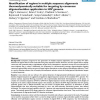Free Online Productivity Tools
i2Speak
i2Symbol
i2OCR
iTex2Img
iWeb2Print
iWeb2Shot
i2Type
iPdf2Split
iPdf2Merge
i2Bopomofo
i2Arabic
i2Style
i2Image
i2PDF
iLatex2Rtf
Sci2ools
BMCBI
2004
2004
Identification of regions in multiple sequence alignments thermodynamically suitable for targeting by consensus oligonucleotides
Background: Computer programs for the generation of multiple sequence alignments such as "Clustal W" allow detection of regions that are most conserved among many sequence variants. However, even for regions that are equally conserved, their potential utility as hybridization targets varies. Mismatches in sequence variants are more disruptive in some duplexes than in others. Additionally, the propensity for self-interactions amongst oligonucleotides targeting conserved regions differs and the structure of target regions themselves can also influence hybridization efficiency. There is a need to develop software that will employ thermodynamic selection criteria for finding optimal hybridization targets in related sequences. Results: A new scheme and new software for optimal detection of oligonucleotide hybridization targets common to families of aligned sequences is suggested and applied to aligned sequence variants of the complete HIV-1 genome. The scheme employs sequential f...
| Added | 16 Dec 2010 |
| Updated | 16 Dec 2010 |
| Type | Journal |
| Year | 2004 |
| Where | BMCBI |
| Authors | Olga V. Matveeva, Brian T. Foley, Vladimir A. Nemtsov, Raymond F. Gesteland, Senya Matsufuji, John F. Atkins, Aleksey Y. Ogurtsov, Svetlana A. Shabalina |
Comments (0)

